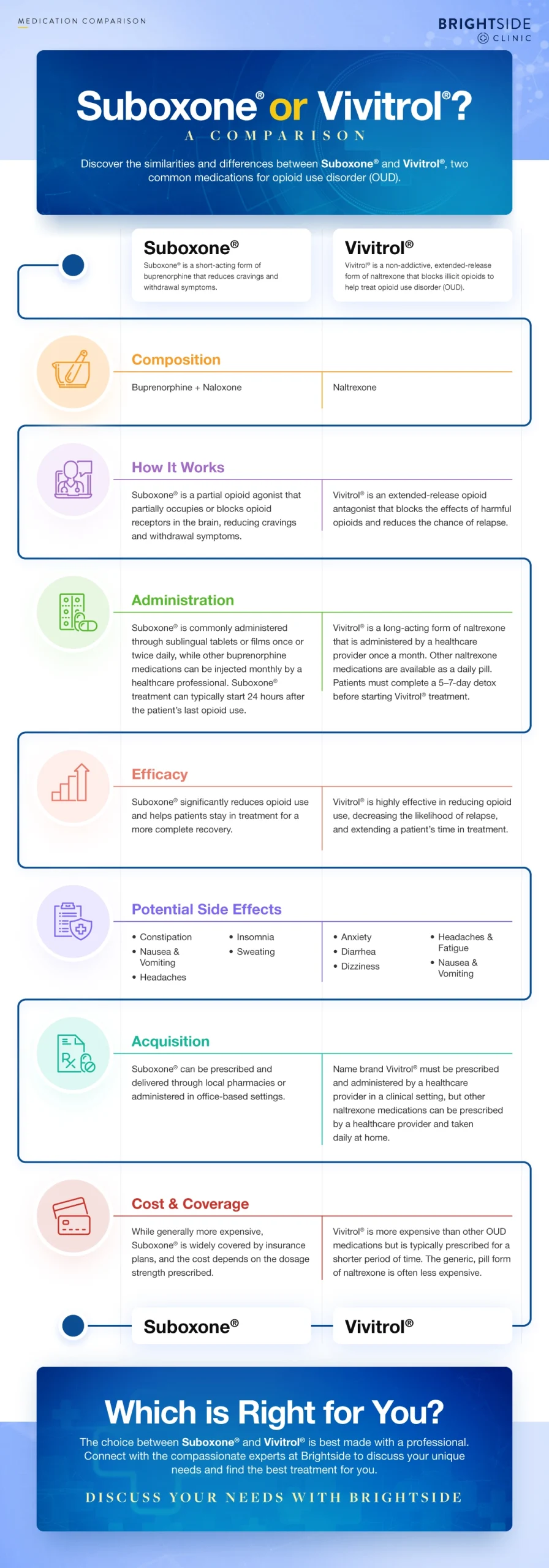Suboxone® vs. Vivitrol®: Similarities, Differences, and Considerations
Opioid use disorder affects individuals, families, and communities across the world, with more than 80,000 people passing away due to opioid overdose in 2021 alone. Beyond the potentially fatal consequences of opioid use disorder, consistent, long-term use of opioids can take a severe toll on the human brain, altering its chemistry and function to a degree that worsens the dependence and makes recovery much more complex.
Medication-assisted treatment (MAT) can help combat opioid use disorder by combining effective medications with comprehensive counseling. There are many medications available, with Suboxone® and Vivitrol® being two standard options for reducing cravings and helping patients stay in treatment. However, when choosing which medication is best for you, it’s essential to explore the differences in dosage, administration, and side effects to determine the most effective option.

Medication-Assisted Treatment for Alcohol and Opioid Dependence
Medication-assisted treatment (MAT) combines compassionate counseling and behavioral therapy services with FDA-approved medication to effectively treat opioid use disorder. Unlike medication or counseling alone, MAT addresses the physical aspects of OUD, like withdrawal symptoms and cravings, while also treating the underlying psychological and behavioral aspects of the disorder.
The medications available for MAT are specifically designed to work on the same opioid receptors as the abused opioids in a safe and controlled manner, helping to restore balance in the brain while kickstarting the recovery process. The Food and Drug Administration (FDA) has approved several medications for use in MAT, with the most common being:
Buprenorphine:
Available under brand names such as Brixadi®, Sublocade®, Suboxone®, and Zubsolv®, buprenorphine is a partial opioid agonist. It binds to opioid receptors in the brain without producing the full opioid effect, helping to alleviate withdrawal symptoms and cravings without the high opioid misuse provides.
Methadone:
As a full opioid agonist, Methadone works by binding to the same brain receptors as other opioids, but it does so more gradually without causing the euphoria of drugs like heroin. It helps patients manage long-term withdrawal symptoms and is administered under strict supervision by a practitioner.
Naltrexone:
Used in brand-name drugs such as Vivitrol®, naltrexone is an opioid antagonist, blocking the effects of opioids at the receptor sites in the brain. Naltrexone is mainly used to prevent relapse rather than manage withdrawal symptoms and is suitable for patients already detoxified. This medication is available as a pill or as a monthly injection.
Suboxone® Treatment
Suboxone® is a short-acting form of buprenorphine that can be taken once to three times per day to minimize cravings and help patients overcome opioid use disorder. The medication partially activates opioid receptors in the brain to accomplish this, reducing withdrawal symptoms without the euphoric high or adverse side effects that illicit opioids cause.
Suboxone® is especially effective due to the combination of buprenorphine and naloxone, which is an opioid antagonist that acts as a safety feature. When taken as prescribed, the naloxone component is inactive. Still, if Suboxone® is injected instead of taken under the tongue or inside the cheek, the naloxone activates and blocks opioid effects to reduce misuse potential.
There are four available strengths of Suboxone®, each catering to patients’ needs at different stages of their recovery journey. These strengths include:
- 2 mg buprenorphine/0.5 mg naloxone
- 4 mg buprenorphine/1 mg naloxone
- 8 mg buprenorphine/2 mg naloxone
- 12 mg buprenorphine/3 mg naloxone
While each dose is generally active for about 4 hours, buprenorphine has a long half-life, meaning that Suboxone® stays in your system for approximately 37 hours. This long half-life ensures that a stable level of medication is released in the bloodstream, effectively managing withdrawal symptoms and cravings with one or two daily doses.
With Suboxone®, patients can stay in treatment for more extended periods with reduced withdrawal symptoms, cravings, and misuse potential. However, there are some possible side effects to be aware of, including nausea, vomiting, headaches, sweating, and insomnia.
How is Suboxone® Administered?
Suboxone® is a name-brand version of buprenorphine that is only available as a sublingual film. This film is placed under the tongue or inside the cheek, dissolving to release medication into the membranes in your mouth. This method allows the medication to enter the bloodstream and mitigate cravings and withdrawal symptoms quickly.
Generic versions of buprenorphine are also available for those who may benefit from a less frequent dosing schedule. Unlike Suboxone®, these medications can be administered via injection by a healthcare professional. Brixadi® and Sublocade® are long-acting forms of buprenorphine that can be injected once per month, providing a steady level of medication over an extended period. However, both Suboxone® and its generic equivalents must be prescribed by a doctor. Your prescription will specify the dosage and whether you should take it once or twice daily.
What is Vivitrol®?
Vivitrol® is a non-addictive, extended-release form of the active drug naltrexone. Unlike Suboxone®, Vivitrol® is an opioid antagonist, meaning that it completely occupies opioid receptors in the brain to block the effects of illicit opioids. While Suboxone® can mitigate withdrawal symptoms, Vivitrol® cannot.
However, because Vivitrol® blocks opioid receptors, patients using the medication will be unable to experience the euphoric effects of opioids, helping to reduce relapse potential and keep patients in treatment. Vivitrol® is typically offered to patients coming out of an inpatient program and looking to continue treatment, as it helps patients achieve a more complete recovery.
While Vivitrol® is a highly effective MAT option, there are potential side effects, including nausea and vomiting, sleepiness, headache, decreased appetite, and body aches.
How is Vivitrol® Administered?
Vivitrol® is a name-brand naltrexone medication that is only available via monthly injection and is commonly used to treat opioid use disorder. This injection must be administered in an office setting by a healthcare professional and typically occurs every four weeks. Like Suboxone®, naltrexone is also available in generic forms and is administered through a pill. However, unlike Vivitrol® injections, naltrexone pills are not extended-release medications and must be taken daily to work effectively, making them a common choice for treating alcohol dependence.
The Difference Between Suboxone® and Vivitrol®
While both Suboxone® and Vivitrol® are successful, FDA-approved addiction treatments, they work in different ways, feature different active ingredients, and are effective for different periods.
Suboxone® is primarily composed of buprenorphine, which minimizes withdrawal symptoms and cravings. This medication can be prescribed in a dedicated substance abuse program or through a general doctor and is taken daily by the patient, which makes it easier to acquire than other MAT options. Finally, Suboxone® is a partial opioid agonist, which means it partially activates opioid receptors instead of blocking them.
On the other hand, Vivitrol® is only available in one dose and as a monthly injection, which requires patients to visit a healthcare professional in person every four weeks. It also works differently than Suboxone®; as an opioid antagonist, Vivitrol® blocks opioid receptors entirely to prevent any illicit opioid effects. Because it blocks the receptors instead of occupying them, Vivitrol® treatment cannot begin until a patient is fully detoxified from opioids (typically a 7-14 day period after stopping opioid use) and does not help alleviate withdrawal symptoms.
How to Decide Between Vivitrol® and Suboxone®
Because Vivitrol® and Suboxone® contain different active ingredients, there isn’t a clear winner. Both treatment options are effective in treating opioid use disorder, so the choice typically depends on the severity of your addiction, your medical history and any other medications you’re taking, your preferences, and your health insurance coverage.
When comparing your options, it’s essential to consider your lifestyle and preferences. Some patients may find Suboxone® to be more convenient because it can be taken home and doesn’t require monthly clinic visits. In contrast, others may find Vivitrol® more appealing because of its singular monthly injection and lack of at-home medication management.
Above all, the best way to determine which medication is right for you is by discussing your needs and situation with an expert. The compassionate team at Brightside is always available to help you determine which MAT option will work best for you, taking your lifestyle, budget, and unique situation into consideration when recommending medications.
Access Life-Changing Treatment at Brightside
Whether through Suboxone®, Vivitrol®, or other FDA-approved solutions, medication-assisted treatment can help patients in all stages of dependence overcome opioid use disorder. Suboxone® can relieve withdrawal symptoms, and Vivitrol® can fully block illicit opioid effects. Still, both can effectively help you live a drug-free life.
If you or a loved one are battling opioid use disorder, Brightside is here to help. Our compassionate and professional experts can create a tailored treatment plan that meets your unique needs and addresses all facets of addiction, helping you achieve a complete recovery. We encourage you to schedule a telehealth visit with Brightside today to discuss your unique treatment needs.

